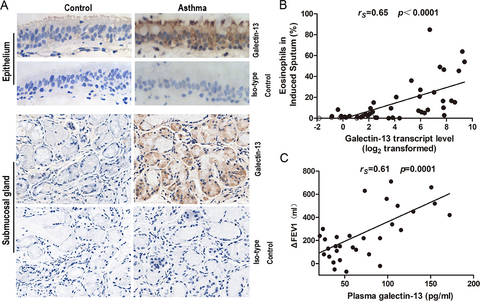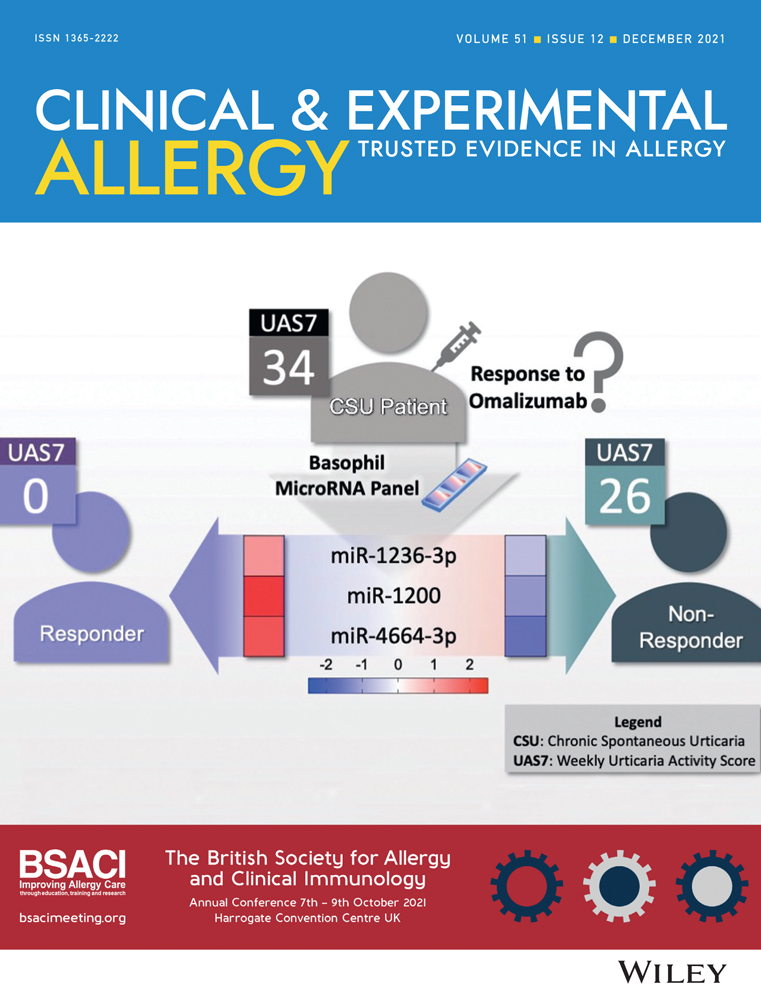Increased epithelial galectin-13 expression associates with eosinophilic airway inflammation in asthma
Funding information
This work was supported by the National Natural Science Foundation of China (grants 81800026, 81670019, 91742108), the National Key Research and Development Program of China (2016YFC1304400), the National Major Science and Technology Project for the Control and Prevention of Major Infectious Diseases of China (2017ZX10103004).
Abstract
Background
Airway eosinophilic inflammation is a central feature in asthma which is mainly driven by type 2 response. The expression of galectin-13 was up-regulated in a parasitic infection model which is also characterized by type 2 immune response. We hypothesized that galectin-13 may be involved in airway eosinophilic inflammation in asthma.
Objective
To unveil the role of galectin-13 in asthma airway inflammation.
Methods
We measured galectin-13 expressions in bronchial brushings, sputum, and plasma of asthma patients (n = 54) and healthy controls (n = 15), and analysed the correlations between galectin-13 expression and airway eosinophilia. We used human bronchial epithelial cell line 16HBE to investigate the possible mechanism by which galectin-13 participates in eosinophilic inflammation.
Results
The expression of galectin-13 was markedly increased in subjects with asthma compared to controls. Epithelial galectin-13 mRNA levels in asthmatic subjects were strongly correlated with eosinophilic airway inflammation (the percentage of sputum eosinophils, the number of eosinophils in bronchial submucosa and FeNO) and the expression of Th2 signature genes (CLCA1, POSTN and SERPINB2). Inhaled corticosteroid (ICS) treatment reduced plasma galectin-13 levels, and baseline plasma galectin-13 levels reflect the response to ICS treatment. In cultured 16HBE cells, knockdown of galectin-13 suppressed IL-13-stimulated MCP-1 and eotaxin-1 expression by inhibiting the activation of EGFR and ERK.
Conclusions & Clinical Relevance
Galectin-13 is a novel marker for airway eosinophilia in asthma, and may contribute to allergic airway eosinophilic inflammation by up-regulating the expression of MCP-1 and eotaxin-1. Plasma galectin-13 levels may be useful for predicting responses to ICS treatment.
Graphical Abstract
Galectin-13 is markedly increased in subjects with asthma and is mainly expressed in airway epithelial cells and submucosal gland cells. Increased galectin-13 expression associates with airway eosinophilic inflammation and may be a candidate signature gene for type 2 status in asthma. Plasma galectin-13 level may be useful for predicting responses to asthma therapy during treatment with inhaled corticosteroid.
CONFLICT OF INTEREST
The authors declare no conflict of interest.
Open Research
DATA AVAILABILITY STATEMENT
I confirm that my article contains a Data Availability Statement even if no data is available (list of sample statements) unless my article type does not require one.
I confirm that I have included a citation for available data in my references section, unless my article type is exempt.





